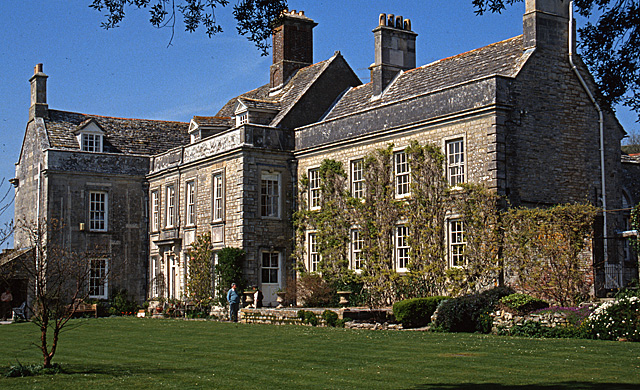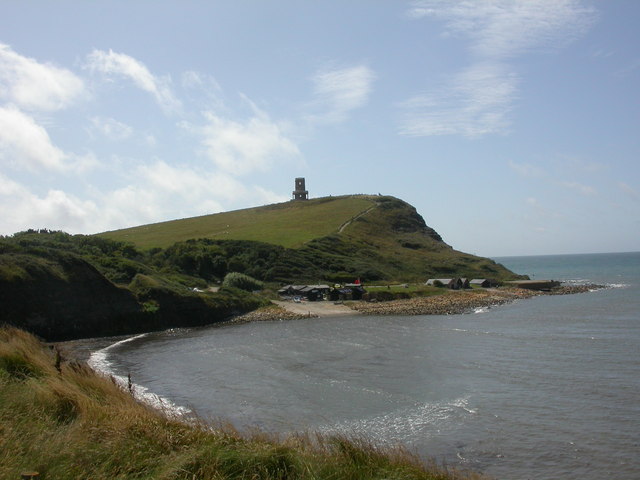|
Kimmeridge
Kimmeridge () is a small village and civil parish on the Isle of Purbeck, a peninsula on the English Channel coast in Dorset, England. It is situated about south of Wareham and west of Swanage. In 2013 the estimated population of the civil parish was 90. Kimmeridge is a coastal parish and its coastline forms part of the Jurassic Coast, a World Heritage Site. The coast is also part of a Site of Special Scientific Interest, and the whole parish is part of the Dorset Area of Outstanding Natural Beauty. Kimmeridge is the type locality for Kimmeridge Clay, the geological formation that covers most of the parish. Within the clay are bands of bituminous shale, which in the history of the village have been the focus of several attempts to create an industrial centre. An oil well has operated on the shore of Kimmeridge Bay since 1959. The village is the origin of the name of the Kimmeridgian stage of the Late Jurassic. The roughly semi-circular Kimmeridge Bay is southwest of Kimm ... [...More Info...] [...Related Items...] OR: [Wikipedia] [Google] [Baidu] |
Kimmeridge Bay
Kimmeridge Bay () is a bay on the Isle of Purbeck, a peninsula on the English Channel coast in Dorset, England, close to and southeast of the village of Kimmeridge, on the Smedmore Estate. The area is renowned for its fossils, with The Etches Collection in the village of Kimmeridge displaying fossils found by Steve Etches in the area over a 30-year period. It is a popular place to access the coast for tourists. To the east are the Kimmeridge Ledges, where fossils can be found in the flat clay beds. Overview Kimmeridge Bay forms part of the Jurassic Coast, a World Heritage Site. The coast is also part of a Site of Special Scientific Interest, and the whole area is part of the Dorset Area of Outstanding Natural Beauty. Kimmeridge is the type locality for Kimmeridge clay, the geological formation that covers most of the area. Within the clay are bands of bituminous shale. An oil well has operated on the shore of Kimmeridge Bay since 1959. The bay is roughly semi-circular, facing ... [...More Info...] [...Related Items...] OR: [Wikipedia] [Google] [Baidu] |
Kimmeridge Clay
The Kimmeridge Clay is a sedimentary deposit of fossiliferous marine clay which is of Late Jurassic to lowermost Cretaceous age and occurs in southern and eastern England and in the North Sea. This rock formation is the major source rock for North Sea oil. The fossil fauna of the Kimmeridge Clay includes turtles, crocodiles, sauropods, plesiosaurs, pliosaurs and ichthyosaurs, as well as a number of invertebrate species. Description Kimmeridge Clay is named after the village of Kimmeridge on the Dorset coast of England, where it is well exposed and forms part of the Jurassic Coast World Heritage Site. Onshore, it is of Late Jurassic ( Kimmeridgian) age and outcrops across England, in a band stretching from Dorset in the south-west, north-east to North Yorkshire. Offshore, it extends into the Lower Cretaceous (Berriasian Stage) and it is found throughout the Southern, Central and Northern North Sea. The foundations of the Humber Bridge on the southern (Barton) side of the ... [...More Info...] [...Related Items...] OR: [Wikipedia] [Google] [Baidu] |
Kimmeridge Clay
The Kimmeridge Clay is a sedimentary deposit of fossiliferous marine clay which is of Late Jurassic to lowermost Cretaceous age and occurs in southern and eastern England and in the North Sea. This rock formation is the major source rock for North Sea oil. The fossil fauna of the Kimmeridge Clay includes turtles, crocodiles, sauropods, plesiosaurs, pliosaurs and ichthyosaurs, as well as a number of invertebrate species. Description Kimmeridge Clay is named after the village of Kimmeridge on the Dorset coast of England, where it is well exposed and forms part of the Jurassic Coast World Heritage Site. Onshore, it is of Late Jurassic ( Kimmeridgian) age and outcrops across England, in a band stretching from Dorset in the south-west, north-east to North Yorkshire. Offshore, it extends into the Lower Cretaceous (Berriasian Stage) and it is found throughout the Southern, Central and Northern North Sea. The foundations of the Humber Bridge on the southern (Barton) side of the ... [...More Info...] [...Related Items...] OR: [Wikipedia] [Google] [Baidu] |
Smedmore House
Smedmore House is a country house near Kimmeridge, Dorset, in England. It was originally built by Sir William Clavell around 1620, partially rebuilt by Edward Clavell around 1700, and greatly augmented by George Clavell around 1760. It is a Grade II* listed building. It is not normally open to the public, although there are regular open days and the House can be rented or hired for functions.Ruth Guilding, 'Estate Expectations', ''The World of Interiors'' (September 2014) History The manor of Smedmore, near Kimmeridge, had historically belonged to the Smedmore family, however they sold it to William Wyot in 1392. Around 1426 it passed into the Clavell family with the marriage of William's granddaughter Joanna to John Clavell. The Clavells also inherited the manor of Barneston, near Church Knowle, from Joanna's cousin John de Stoke, and it was Barneston that was to be their main residence for the next 200 years. John Clavell's descendant Sir William Clavell (1568–1644) earne ... [...More Info...] [...Related Items...] OR: [Wikipedia] [Google] [Baidu] |
Jurassic
The Jurassic ( ) is a geologic period and stratigraphic system that spanned from the end of the Triassic Period million years ago (Mya) to the beginning of the Cretaceous Period, approximately Mya. The Jurassic constitutes the middle period of the Mesozoic Era and is named after the Jura Mountains, where limestone strata from the period were first identified. The start of the Jurassic was marked by the major Triassic–Jurassic extinction event, associated with the eruption of the Central Atlantic Magmatic Province. The beginning of the Toarcian Stage started around 183 million years ago and is marked by an extinction event associated with widespread oceanic anoxia, ocean acidification, and elevated temperatures likely caused by the eruption of the Karoo-Ferrar large igneous provinces. The end of the Jurassic, however, has no clear boundary with the Cretaceous and is the only boundary between geological periods to remain formally undefined. By the beginning of the Jurassi ... [...More Info...] [...Related Items...] OR: [Wikipedia] [Google] [Baidu] |
Isle Of Purbeck
The Isle of Purbeck is a peninsula in Dorset, England. It is bordered by water on three sides: the English Channel to the south and east, where steep cliffs fall to the sea; and by the marshy lands of the River Frome and Poole Harbour to the north. Its western boundary is less well defined, with some medieval sources placing it at Flower's Barrow above Worbarrow Bay. John Hutchins, author of ''The History and Antiquities of the County of Dorset'', defined Purbeck's western boundary as the Luckford Lake steam, which runs south from the Frome. According to writer and broadcaster Ralph Wightman, Purbeck "is only an island if you accept the barren heaths between Arish Mell and Wareham as cutting off this corner of Dorset as effectively as the sea." The most southerly point is St Alban's Head (archaically St. Aldhelm's Head). From 1974 to 2019, the whole of the Isle of Purbeck lay within the local government district of Purbeck, which was named after it. The district extended si ... [...More Info...] [...Related Items...] OR: [Wikipedia] [Google] [Baidu] |
Kimmeridgian
In the geologic timescale, the Kimmeridgian is an age in the Late Jurassic Epoch and a stage in the Upper Jurassic Series. It spans the time between 157.3 ± 1.0 Ma and 152.1 ± 0.9 Ma (million years ago). The Kimmeridgian follows the Oxfordian and precedes the Tithonian. Stratigraphic definition The Kimmeridgian Stage takes its name from the village of Kimmeridge on the Dorset coast, England. The name was introduced into the literature by French geologist Alcide d'Orbigny in 1842. The Kimmeridge Clay Formation takes its name from the same type location (although this formation extends from the Kimmeridgian stage of the Upper Jurassic into the Lower Cretaceous). It is the source for about 95% of the petroleum in the North Sea. Historically, the term Kimmeridgian has been used in two different ways. The base of the interval is the same but the top was defined by British stratigraphers as the base of the Portlandian (''sensu anglico'') whereas in France the top was defined ... [...More Info...] [...Related Items...] OR: [Wikipedia] [Google] [Baidu] |
Bituminous Shale
Oil shale is an organic-rich fine-grained sedimentary rock containing kerogen (a solid mixture of organic chemical compounds) from which liquid hydrocarbons can be produced. In addition to kerogen, general composition of oil shales constitutes inorganic substance and bitumens. Based on their deposition environment, oil shales are classified as marine, lacustrine and terrestrial oil shales. Oil shales differ from oil-''bearing'' shales, shale deposits that contain petroleum ( tight oil) that is sometimes produced from drilled wells. Examples of oil-''bearing'' shales are the Bakken Formation, Pierre Shale, Niobrara Formation, and Eagle Ford Formation. Accordingly, shale oil produced from oil shale should not be confused with tight oil, which is also frequently called shale oil. Deposits of oil shale occur around the world, including major deposits in the United States. A 2016 estimate of global deposits set the total world resources of oil shale equivalent of of oil in ... [...More Info...] [...Related Items...] OR: [Wikipedia] [Google] [Baidu] |
Dorset
Dorset ( ; archaically: Dorsetshire , ) is a county in South West England on the English Channel coast. The ceremonial county comprises the unitary authority areas of Bournemouth, Christchurch and Poole and Dorset. Covering an area of , Dorset borders Devon to the west, Somerset to the north-west, Wiltshire to the north-east, and Hampshire to the east. The county town is Dorchester, in the south. After the reorganisation of local government in 1974, the county border was extended eastward to incorporate the Hampshire towns of Bournemouth and Christchurch. Around half of the population lives in the South East Dorset conurbation, while the rest of the county is largely rural with a low population density. The county has a long history of human settlement stretching back to the Neolithic era. The Romans conquered Dorset's indigenous Celtic tribe, and during the Early Middle Ages, the Saxons settled the area and made Dorset a shire in the 7th century. The first recor ... [...More Info...] [...Related Items...] OR: [Wikipedia] [Google] [Baidu] |
Jurassic Coast
The Jurassic Coast is a World Heritage Site on the English Channel coast of southern England. It stretches from Exmouth in East Devon to Studland Bay in Dorset, a distance of about , and was inscribed on the World Heritage List in mid-December 2001. The site spans 185 million years of geological history, coastal erosion having exposed an almost continuous sequence of rock formation covering the Triassic, Jurassic and Cretaceous periods. At different times, this area has been desert, shallow tropical sea and marsh, and the fossilised remains of the various creatures that lived here have been preserved in the rocks. Natural features seen on this stretch of coast include arches, pinnacles and stack rocks. In some places the sea has broken through resistant rocks to produce coves with restricted entrances and, in one place, the Isle of Portland is connected to the land by a barrier beach. In some parts of the coast, landslides are common. These have exposed a wide range of foss ... [...More Info...] [...Related Items...] OR: [Wikipedia] [Google] [Baidu] |
Surfing
Surfing is a surface water sport in which an individual, a surfer (or two in tandem surfing), uses a board to ride on the forward section, or face, of a moving wave of water, which usually carries the surfer towards the shore. Waves suitable for surfing are primarily found on ocean shores, but can also be found in standing waves in the open ocean, in lakes, in rivers in the form of a tidal bore, or in wave pools. The term ''surfing'' refers to a person riding a wave using a board, regardless of the stance. There are several types of boards. The Moche of Peru would often surf on reed craft, while the native peoples of the Pacific surfed waves on alaia, paipo, and other such water craft. Ancient cultures often surfed on their belly and knees, while the modern-day definition of surfing most often refers to a surfer riding a wave standing on a surfboard; this is also referred to as stand-up surfing. Another prominent form of surfing is body boarding, where a surfer rides th ... [...More Info...] [...Related Items...] OR: [Wikipedia] [Google] [Baidu] |
South Dorset (UK Parliament Constituency)
South Dorset is a constituency represented in the House of Commons of the UK Parliament since 2010 by Richard Drax, a Conservative. The constituency was created as a consequence of the Redistribution of Seats Act 1885, although the area covered has changed since then. History Formation The constituency was created as a consequence of the Redistribution of Seats Act 1885. The Act reduced the number of MPs.in Dorset from 10 to 4 (see Redistribution of Seats Act 1885#Redistributed seats: England). It was initially proposed to name the new constituencies after existing boroughs (Shaftesbury, Dorchester, Poole and Bridport) but, following an amendment in the Commons on 14 April 1885, the names were changed to the points of the compass (North Dorset, South Dorset, East Dorset, West Dorset). The South Dorset constituency was divided into 7 polling districts. Dorchester was chosen as the place where the nomination of candidates would take place and the result would be declare ... [...More Info...] [...Related Items...] OR: [Wikipedia] [Google] [Baidu] |




_-_geograph.org.uk_-_648794.jpg)





